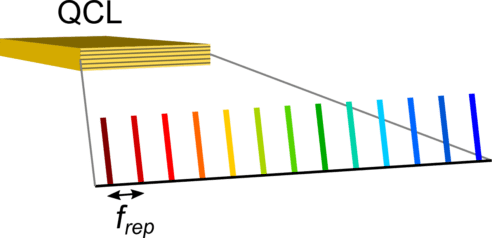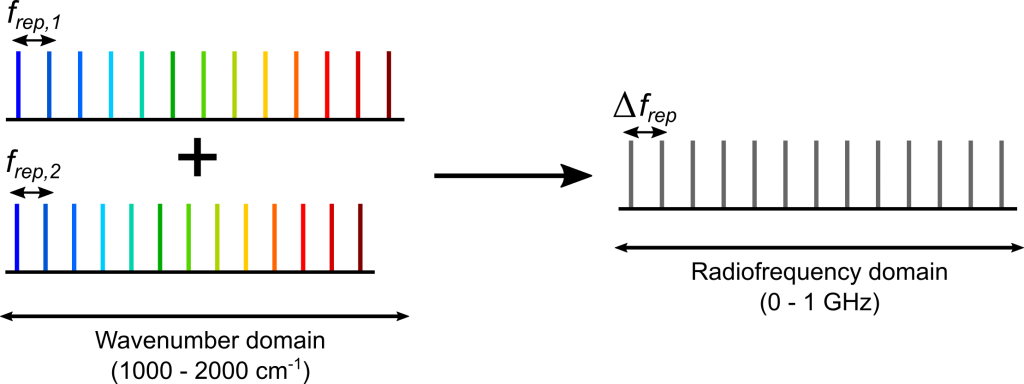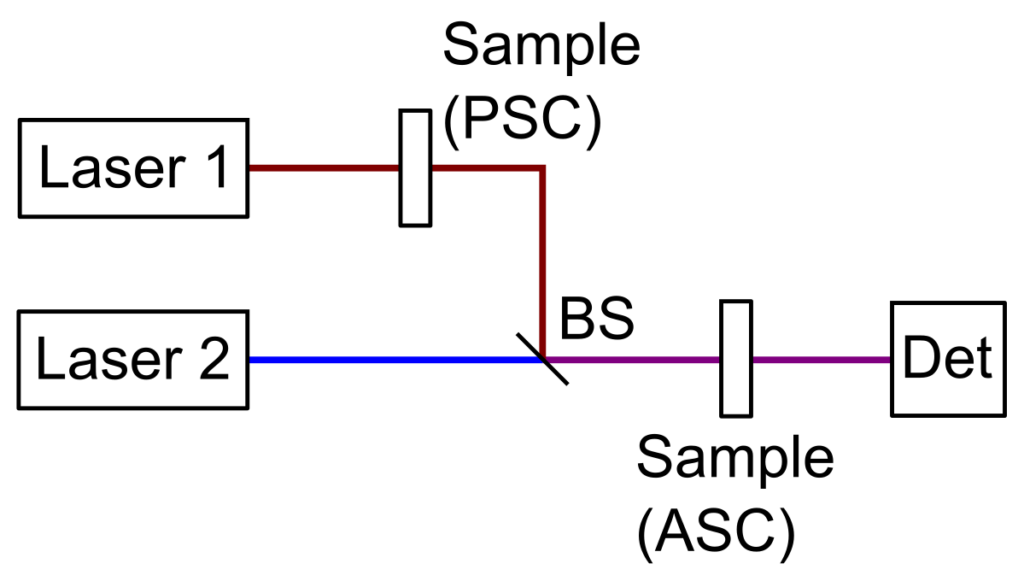Dual comb spectroscopy: a new way of observing the mid-infrared
IRsweep’s infrared spectrometers are based on frequency comb technology. It relies on fundamentallydifferent principles to other types of spectrometers, providing real advantages over both FTIR and single-wavelength laser-based mid-IR spectrometers. No moving parts are used from the generation of light to the detection.
So how does it work?
Frequency combs
IRsweep employs frequency comb laser sources. These arebroadband lasers that emit not at one but at many discrete wavelengths, making them distinct from both classical single-line as well as supercontinuum sources. Such a source is depicted in the schematic. Importantly, the line-spacing (or frep) of frequency combs is extremely well defined, and this is one of the properties that makes them useful for spectroscopy.
The frequency comb sources used in our spectrometers are based on quantum cascade lasers (QCLs). These are electrically-pumped semiconductor devices, which are robust and straightforward to use by our end-users. As co-discovered by one of IRsweep’s founders, it is the engineering of the devices that allow them to behave as frequency combs. Their output powers can be many hundreds of milliwatts and the exact spectral profile and frep of each laser can be carefully controlled by changing the current and device temperature. The QCLs in the IRis-F1 come pre-aligned and pre-set, requiring little to no maintenance.

Heterodyne detection
Two frequency combs lasers are used for spectroscopy. As shown in the schematic below, their line-spacings (in this case frep,1 and frep,2) are chosen to be similar but not the same. When overlaid on a detector, this produces a heterodyne beating, equivalent to the difference of the two spacings: Δfrep = frep,1 – frep,2. Each comb tooth produces a Δfrep signal with each comb tooth from the second laser. We detect this signal by choosing frep,1 and frep,2 in such a way that Δfrep is on the order of 1 to 5 MHz; therefore, the entire heterodyne beating pattern can be recovered from a high-bandwidth detector. Crucially, this detection method requires no scanning, and the entire spectrum is recorded in a time-frame of 1/Δfrep (ca. 1 μs).
Improved measurements compared to FTIR
Aside from being completely solid-state, there are many other advantages dual-comb spectroscopy has to offer over other approaches.
Speed
Making good use of being a solid-state device, the IRis-F1 measures at 4 μs per spectrum, with the potential to go to 1 μs. Importantly, in a single measurement block (up to ca. 130 ms) the measurement-to-measurement-time is zero. This means that, in the case of a 130 ms measurement, more than 33000 spectra are recorded sequentially in this time-frame. To bridge the microsecondtimescale with the millisecondto secondto minutetimescales, it is possible to carry out rapidly repeating measurements, with shorter measurement blocks. This allows repetition rates of 40 Hz to be achieved with good signal to noise ratios, as demonstrated here.

Brightness
Frequency comb QCLs are laser sources and are ideally suitable to photon-hungry applications. For example, measurements of optically dense samples become possible. Importantly, many time-resolved applications are photon-limited and in this case a higher brightness means higher signal to noise ratios. See below for a graph that shows how noise levels of a single spectral element of the IRis-F1 compares to a leading FTIR instrument. Even though a high-sensitivity liquid nitrogen cooled detector is used in the FTIR, the laser source enables far lower deviations in signal to be reached.

Bandwidth
Compared to single-mode laser systems and distributed feedback QCLs, the IRis-F1 is relatively broad-band, with a spectral bandwidth of 60-80 cm-1. This enables the simultaneous observation of several species, the accurate correction of baseline artifacts and gives more data for fitting, turning many questions in chemistry into overdefined problems. The laser’s frequency can be readily changed by swapping the laser module.
Rapid full-spectrum acquisition
Since the whole spectrum is recorded in microseconds, any environmental changes in the sample can be observed, monitored and used to improve the analysis. For instance, sample degradation can be evaluated with every shot, changes in the baseline can be tracked, there is no spectral hysteresis, and drifts due to heating are not simply averaged out and do not distort the overall spectra as is the case with step-scan FTIR measurements.
Two configurations
The IRis-F1 comes in two main configurations, namely amplitude sensitive (ASC) and phase sensitive (PSC). The difference in these configurations is mainly given by whether the sample is placed before or after the beam combining. In other words, in the ASC, both lasers travel through the sample, and in the PSC, only one laser travels through the sample, as shown in the figure.
The main advantage of the ASC instrument is that both lasers are absorbed, and this leads to a greater sensitivity to changes in transmission. In this configuration, Laser 1 and Laser 2 are not experimentally distinguished. However, since the output frequencies of the lasers are not completely identical (see above), there is an uncertainty as to which of the two is absorbed by the sample. This effectively limits the spectral resolution to the bandwidth of the digitizer, ca. 0.033 cm-1.

With the PSC instrument, this limitation does not exist. Only one of the lasers is absorbed by the sample and the second laser acts as a local oscillator, so it is clear from where any changes in transmission arise. This also means that the phase shift induced by the sample can be measured. The drawbacks of the PSC are that it requires a more complex optical setup and since the beams are combined after much longer distances, the instrument can be more sensitive to external changes such as vibrations. Furthermore, the amplitude advantage of absorbing both lasers is no longer present.
Keep reading: Application notes
- IRcell-S coupled to FTIR spectrometer
- Diffuse reflectance dual comb mid-IR spectroscopy for heterogeneous catalysis
- Mid-IR PAT with 10 meter fiber probes
- Millisecond protein kinetics studied by stopped-flow with mid-IR dual comb spectroscopy
- Infrared stopped-flow at 220 spectra per second: a new addition to the toolbox
- Dental curing
- Stopped flow as a way to study chemical reactions
- Blending: active pharmaceutical ingredients quantification
- Rapid reaction monitoring of curing processes with the IRis-F1
- Measurement of optically dense samples with the IRis-F1